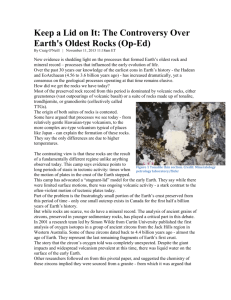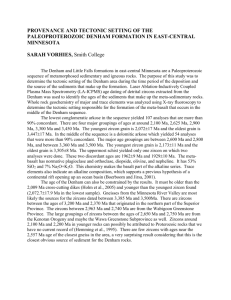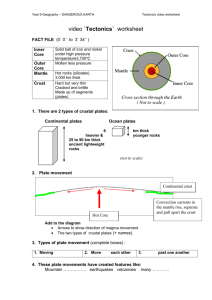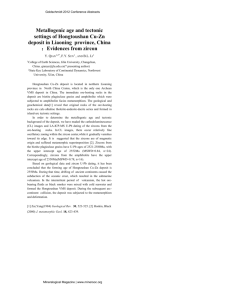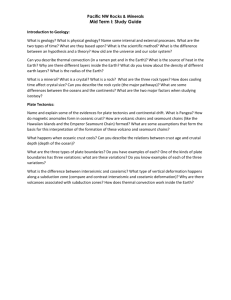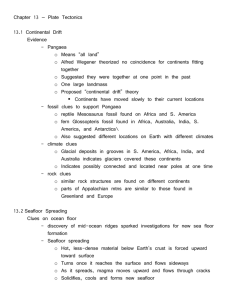A New Picture of the Early Earth
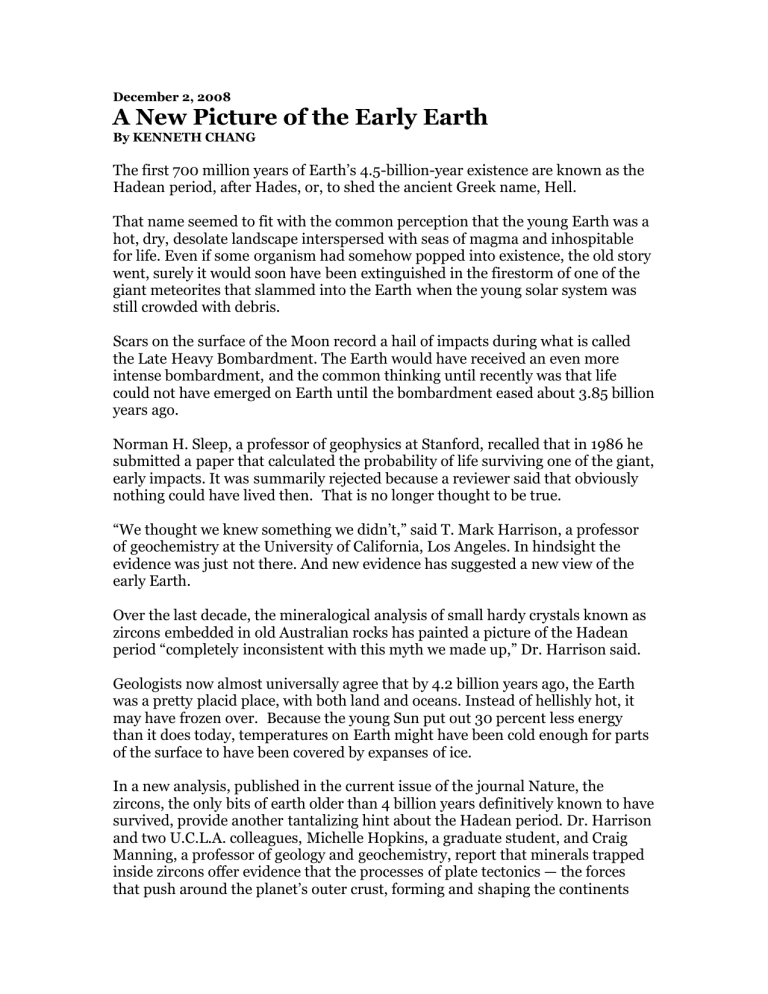
December 2, 2008
A New Picture of the Early Earth
By KENNETH CHANG
The first 700 million years of Earth’s 4.5-billion-year existence are known as the
Hadean period, after Hades, or, to shed the ancient Greek name, Hell.
That name seemed to fit with the common perception that the young Earth was a hot, dry, desolate landscape interspersed with seas of magma and inhospitable for life. Even if some organism had somehow popped into existence, the old story went, surely it would soon have been extinguished in the firestorm of one of the giant meteorites that slammed into the Earth when the young solar system was still crowded with debris.
Scars on the surface of the Moon record a hail of impacts during what is called the Late Heavy Bombardment. The Earth would have received an even more intense bombardment, and the common thinking until recently was that life could not have emerged on Earth until the bombardment eased about 3.85 billion years ago.
Norman H. Sleep, a professor of geophysics at Stanford, recalled that in 1986 he submitted a paper that calculated the probability of life surviving one of the giant, early impacts. It was summarily rejected because a reviewer said that obviously nothing could have lived then.
That is no longer thought to be true.
“We thought we knew something we didn’t,” said T. Mark Harrison, a professor of geochemistry at the University of California, Los Angeles. In hindsight the evidence was just not there. And new evidence has suggested a new view of the early Earth.
Over the last decade, the mineralogical analysis of small hardy crystals known as zircons embedded in old Australian rocks has painted a picture of the Hadean period “completely inconsistent with this myth we made up,” Dr. Harrison said.
Geologists now almost universally agree that by 4.2 billion years ago, the Earth was a pretty placid place, with both land and oceans. Instead of hellishly hot, it may have frozen over.
Because the young Sun put out 30 percent less energy than it does today, temperatures on Earth might have been cold enough for parts of the surface to have been covered by expanses of ice.
In a new analysis, published in the current issue of the journal Nature, the zircons, the only bits of earth older than 4 billion years definitively known to have survived, provide another tantalizing hint about the Hadean period. Dr. Harrison and two U.C.L.A. colleagues, Michelle Hopkins, a graduate student, and Craig
Manning, a professor of geology and geochemistry, report that minerals trapped inside zircons offer evidence that the processes of plate tectonics — the forces that push around the planet’s outer crust, forming and shaping the continents
and oceans — had already begun.
“The picture that’s emerging is a watery world with normal rock recycling processes,” said Stephen J. Mojzsis, a professor of geology at the University of
Colorado who was not involved with the U.C.L.A. research. “And that’s a comforting thought for the origin of life.”
With the old views of the Hadean period, the origin of life on Earth posed a huge problem.
The earliest, and still debated, evidence for life lies within rocks in
Greenland dated at 3.83
billion years. The rocks show a shift in the relative amounts of carbon-12, the usual form of carbon, and carbon-13, a less common but stable form of carbon. That shift was attributed to the presence of microorganisms, which would tend to concentrate the lighter carbon.
What was surprising, perhaps unbelievable, in the old views was that life started immediately at the end of the Late Heavy Bombardment, seemingly showing up the instant that it was possible.
In the new view of the early Earth, life could have emerged hundreds of millions of years earlier. “This means the door is open for a long, slow chemical evolution,” Dr. Mojzsis said.
“The stage was set for life probably 4.4 billion years ago, but I don’t know if the actors were present.”
The revolution in early Earth studies comes largely from rocks in western
Australia. The rocks are three billion years old, but they contain zircons that are older. Zircons, made primarily of the elements zirconium, oxygen and silicon, are extremely hard and durable and can survive conditions that erode, melt or otherwise transform the rock around them.
The zircons also contain enough uranium that they can be precisely dated by the decay of that uranium. In 2001, two groups, one led by Dr. Harrison and the other by John W. Valley of the University of Wisconsin, reported that the
Australian zircons formed during the Hadean period as long ago as 4.4 billion years and were later embedded in the younger, 3-billion-year-old rocks.
The relative amounts of oxygen isotopes in the zircons points to the presence of water.
Minerals like clays and carbonates that form in water prefer to incorporate oxygen-18 into their crystal structure, and the zircons contain relatively high levels of oxygen-18 compared to the more common oxygen-16.
In the U.C.L.A. study, the researchers studied tiny mineral grains trapped inside the zircons between 4 billion and 4.2 billion years ago as they were being formed.
From the mix of elements they identified in the minerals, the scientists could calculate the depth and temperature at which the zircons crystallized — 1,300 degrees Fahrenheit at a depth of 15 miles — and the calculations showed a flow of heat coming out of that part of the Earth of 75 milliwatts per square meter.
That is too cool. The Earth during the Hadean period may not have been hellish, but it was hotter than today, and the heat flow should have been about three times the amount that was calculated.
That meant the zircons formed in a cool part of the crust. On Earth today, one such place is a subduction zone, where an ocean plate slides under a continental plate and is pushed into the mantle. The waterlogged ocean plate then melts at relatively low temperatures. The U.C.L.A. scientists believe that the high water content and the low temperatures inferred from the zircons thus point to the existence of such a subduction zone. And a subduction zone could not have existed unless some type of plate tectonics was already at work.
“It’s not a smoking gun,” Dr. Harrison said. “But we’re left without any other plausible explanation.”
Many geologists believe that the crust was too thin or the interior too hot for plate tectonics to occur back then. Neither Venus nor Mars shows obvious signs of plate tectonics, past or present, suggesting that only a limited range of planetary temperature and structure give rise to the phenomenon.
Dr. Sleep of Stanford said of the U.C.L.A. findings: “It may well be a subduction zone. It looks like a subduction zone.”
Dr. Valley has also concluded the Earth became cool and watery early in its history, but remains skeptical about the inferences about plate tectonics.
“To me, it’s not ruled out by anything,” he said, “but it’s far from proven with the certainty that Mark states it.” Dr. Valley said it was possible that some of the elements measured by the U.C.L.A. researchers might have infiltrated the zircons through tiny cracks.
If plate tectonics were overturning the Earth’s crust during the Hadean period, it would have shaped not just the land forms, but also the air and the climate.
In the 1980s, a climate model proposed a thick atmosphere of heat-trapping carbon dioxide, raising the average surface temperature to 185 degrees
Fahrenheit, not quite boiling.
But if plate tectonics had already begun, much of the carbon dioxide would be trapped in carbonate rocks and then pushed into Earth’s interior. In 2001, a climate model by Dr. Sleep and Kevin Zahnle of the NASA Ames Research Center found that the late Hadean Earth then would have been somewhat chilly.
Neither near-boiling temperatures nor the chilly conditions make life impossible, but these factors could change ideas about how and when life started.
Earth, like the other planets, coalesced more than 4.5 billion years ago. It is commonly hypothesized that almost immediately, a Mars-size object about 4,000
miles wide hit it — a true cataclysm that vaporized much of the object and Earth.
Some of the debris ejected into orbit became the Moon. The molten Earth cooled quickly, probably within a few million years, and nothing that large ever struck again.
Dr. Sleep said his calculations suggested that during the 700 million years of the
Hadean period about 15 objects 100 miles wide or wider hit the Earth. About four of the objects were wider than 200 miles, and those collisions would have been violent enough to boil off most of the oceans. (By contrast, the more recent object that hit the Earth 65 million years ago and helped kill off the dinosaurs was about
6 miles wide.)
But in numerical simulations that will be presented this month at a meeting of the American Geophysical Union in San Francisco, Dr. Mojzsis and Oleg
Abramov, a postdoctoral researcher at the University of Colorado, show that the
Late Heavy Bombardment impacts were not quite as lethal as had been thought.
“Things are hurt really bad,” Dr. Mojzsis said. But the computer calculations indicated that even rocks up to 300 miles wide would not kill everything, that pockets would exist where organisms that thrive in high-temperature environments like hydrothermal vents could survive.
Genetic studies of current life support that notion, pointing to an organism that lived in a high-temperature environment as the last common ancestor. That does not mean that life started there, but that is almost certainly where survivors of the giant impacts would have huddled.
For the question of whether life existed during the Hadean period, researchers would like to find carbon and then perform an isotope analysis similar to what was done with the Greenland rocks. Despite analyzing 160,000 grain-size zircons, the U.C.L.A. researchers have not found carbon. (Another group has reported the presence of small diamonds, but that has not been confirmed.)
The search for more substantial amounts of Hadean rock also continues. Three months ago, researchers reported that a swath of bedrock in northern Quebec might be 4.28 billion years old, which would provide a mother lode of material to study. That bedrock includes intriguing structures known as banded iron formations, which are believed to occur only with the help of living organisms.
But other scientists have questioned the age of the rocks, suggesting that they may really be 3.8 billion years old.
Dr. Mojzsis said “Hadean” might not be a misleading name for the earliest eon of
Earth’s history, after all. The ancient Greek concept of hell was not one of fire and brimstone. “In Greek mythology, Hades was a dark, cold, mysterious place,” he said. “It seems to me the Hadean is living up to that moniker.”
Copyright 2008 The New York Times Company
Privacy Policy Search Corrections
RSS
First Look Help Contact Us Work for Us Site Map
